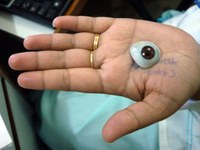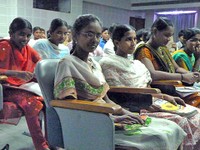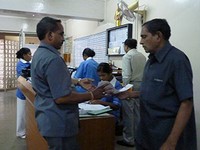 Today, the L.V. Prasad Eye Institute, located in the city of Hyderabad in south central India, is one the country's most renowned clinical and medical research centres, caring for the eye needs of tens of thousands of Indians and pursuing cutting-edge research into a variety of eye diseases.
Today, the L.V. Prasad Eye Institute, located in the city of Hyderabad in south central India, is one the country's most renowned clinical and medical research centres, caring for the eye needs of tens of thousands of Indians and pursuing cutting-edge research into a variety of eye diseases.
The L.V. Prasad Eye Institute, which is serving as the local host for the TWAS 21st General Meeting, marks the fulfilment of a vision held Dr. G.N. Rao.
Rao's dream was to bring to India the same level of eye care and eye research that he had witnessed in the United States, first as a student and then as a medical researcher. In the early 1980s, Rao met L.V. Prasad, a successful Indian film maker, who was looking to put his wealth to work for a good cause. Rao convinced Prasad that his vision of an eye care clinic and research centre would be a worthy investment. In 1985, the institute that bears its benefactor's name opened its doors.
 From modest beginnings, L.V. Prasad Eye Institute now employs 400 people, including 25 ophthalmologists and 15 medical researchers focusing on caring for eye diseases for the general population and undertaking research that can help overcome and more effectively treat these diseases.
From modest beginnings, L.V. Prasad Eye Institute now employs 400 people, including 25 ophthalmologists and 15 medical researchers focusing on caring for eye diseases for the general population and undertaking research that can help overcome and more effectively treat these diseases.
Patient care leads the list of responsibilities at the institute. Indeed doctors see a remarkable 750 patients each day. Half of the patients do not pay for the services they receive. More well-to-do patients pay from 250 Indian to 750 Indian rupees (USD5.00 to USD15.00) for a consultation visit.
 "Rich and poor receive the same care," says Shaik Yousuf Arfath, administrator of the institute's education centre. Those who pay receive better amenities – a less crowded waiting room or more private quarters if they need to stay overnight. "But we never compromise on the clinical services regardless of a patient's ability to pay. In fact, our stair-stepped payment system allows those who can afford to pay to subsidize those who cannot."
"Rich and poor receive the same care," says Shaik Yousuf Arfath, administrator of the institute's education centre. Those who pay receive better amenities – a less crowded waiting room or more private quarters if they need to stay overnight. "But we never compromise on the clinical services regardless of a patient's ability to pay. In fact, our stair-stepped payment system allows those who can afford to pay to subsidize those who cannot."
The institute also has nine operating theatres where, on average, doctors perform 100 surgeries each day, ranging from laser-based cataract removals to cornea transplants. According to Arfath, the institute carries out the largest number of cornea transplants in the world. In 2009, the total exceeded 1,500. Again, half of all the surgeries are done cost free and half are done on sliding price scale based on the patient's ability to pay.
The institute also has an active research programme. For example, its stem cell research laboratory has successfully used limbal stem cells to reconstruct the damaged corneas of burn victims to restore their vision. Currently, the laboratory is seeking to induce pluripotent stem cells to develop into ocular cells for possible use in genetic therapies to treat diseases of the retinue. In addition, it is investigating cellular properties that spur the development of cancerous tumours or that create resistance to chemotherapy.
There's also a molecular genetics laboratory where researchers study mutant genes that might be responsible for macular degeneration and congenital hereditary endothelal.
And researchers in the institute's biochemistry laboratory focus on crystallines, the proteins responsible for the physical structure of the eye. A hardening of the crystallines is a major cause of cataracts.
"Excellence and equity have been the hallmark of the L.V. Prasad Eye Institute since G.N. Rao and L.V. Prasad first envisioned the institute a quarter a century ago," says Dorairajan Balasubramanian, director of research and TWAS secretary general.
"The success of the institute is living proof that clinical medicine and medical research work best when they work together – and that strong synergies develop when you serve people and pursue scientific excellence at the same time."

